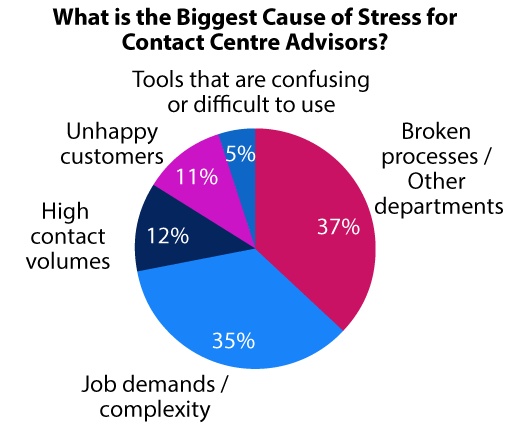Absenteeism is a widespread issue in contact centres, affecting productivity, team morale, and customer service.
Whether it’s due to dissatisfaction with shift schedules, stress from high contact volumes, or a lack of leadership support, the impact is significant.
In this article, we break down the key drivers behind absenteeism and provide a detailed action plan to tackle it.
From identifying root causes to creating effective absence processes and fostering a positive workplace culture, these strategies will help you reduce absenteeism and build a more engaged, reliable workforce.
What Drives Absenteeism?
There a number of reasons why contact centres suffer from higher than average absenteeism rates, and key reasons include:
Schedule Dissatisfaction
Perhaps the team have to work occasional weekends, despite some really disliking having to do so. Or an advisor can’t find a shift-swap, so they have to miss a key family event. Time off and shift patterns are a constant source of frustration in some contact centres.
Lack of Follow-Up
An advisor may have taken a chance and taken a day off once, and observed that there was no detailed follow-up as to why they were away. So, this one-off might develop into a routine, whereby every once in a while, the advisor will decide to take a day off.
Culture
If people don’t like coming to work, they are less likely to come in. So, it is worth taking the time to invest in a positive culture, where fun is built in – perhaps through motivational games, charity fundraisers and afternoon pick-me-ups.
Stress
There are a number of sources of stress in the contact centre, including fire-fighting high contact volumes, job complexity and unhappy customers, which can lead to high levels of stress. But it’s broken processes that cause the most stress, according to our poll, and heighten absenteeism.

This poll has been sourced from our webinar: Building a Positive Culture in the Contact Centre
Team Leaders
There is the argument that bad team leaders stem from a bad organisational culture, which is often the case, but any team leader should be given the following messages:
- Be prepared to have difficult conversations
- Treat each member of the team as equal
- Create a team feedback loop
- Get to know your advisors personally
If the team leader ignores any of these four messages, absenteeism could well spike.
We discuss more about these messages, and why they are so important, in our article: How to Develop Team Leaders in the Contact Centre
How to Create an Action Plan for Dealing With Absenteeism
We’ve put together an action plan for absenteeism in the call centre, and what you need to include.
1. Distinguish Between Long-Term and Short-Term Absence
Lots of contact centres will calculate a figure for absenteeism using the equation below and dig no further into the result. This can be a mistake.
Use the Bradford Formula
The Absenteeism Formula is Absenteeism (%) = Number of Hours Taken off for Unauthorised Absence ÷ Total Hours Scheduled by the Workforce over the Period x 100

We can understand the logic behind this. After all, if your absence rates are going down, your contact centre is doing well, right?
Well, not necessarily. This is because the overall figure may be going down because long-term absenteeism has fallen, while short-term sick may be skyrocketing.
So, create a rule that anything:
- Shorter than five days = short-term absenteeism
- Longer than five days = long-term absenteeism
Then, create two different absence calculations, tracking each separately. This will remove lots of ambiguity.
You can do so by adapting the formula above, but a better method is to use the Bradford Factor equation:
The The Bradford Factor (%) Formula is = (The number of spells of absenteeism in the 12 months)² x (The number of days off in the past 12 months)
For more on the basics of measuring absenteeism in the contact centre, read our article: How to Calculate Absenteeism
2. Look for Trends and Find the Root Cause
Now, dig into your short-term absenteeism calculations even further. Don’t look across the entire year, break your calculations down into months. This gives you a much better chance of isolating root causes.
You may notice common spikes around certain events, which you can then investigate and plan for.

Dan Cuthbert
“There is normally a trend that you can spot,” says Dan Cuthbert, a contact centre expert at Cuthbert Consulting.
“Whether it is with part-timers, full-timers, individual teams in the contact centre or across multiple sites, absenteeism will vary across all of these groups.”
So, divide absence rates into these groups – as well as others – and examine the differences.
“Look for patterns. Consider why and when absence increases. Think about internal and external factors. This will help you to find and address causes for absenteeism within your centre,” concludes Dan.
Another interesting idea is to forecast absenteeism and factor that into your staffing plans. While this won’t help to solve the root cause, it will help to ensure that you have the optimum number of people available to take your customer calls.
3. Understand the Warning Signs
Short-term sickness will likely be the biggest cause for absenteeism within your contact centre. While this is – much of the time – genuine, sometimes it is not.
For these “other times”, there will be an underlying reason behind the absence. It is important that you understand these.
Often there will be a morale issue. Sometimes it will be burnout. A team leader should get to know their team and be empowered to take action before the problem escalates. This is, however, often not the case.
Leaders are hesitant to have difficult conversations to nip problems in the bud.
“Lack of team leader coaching and support frequently means that we miss out on the warning signs of absence – especially in remote environments,” says Dan.
“I have found, in many contact centres, that leaders are hesitant to have difficult conversations to nip problems in the bud. This can lead to a constant cycle of bad morale feeding further bad morale.”
So, coach team leaders to spot the signs and ask them not to shy away from difficult conversations. They will learn from these conversations and, over time, get better at handling such situations.
Find out how to increase morale in your contact centre by reading our article: 11 Creative Tips to Boost Morale in the Contact Centre
4. Create Listening Mechanisms
While digging into your absenteeism trends and training team leaders will give you an idea of what is causing absenteeism, simply talking and listening to advisors can be just as powerful.
You can do anything from simply setting up informal chats to creating a forum where teams can voice their opinions, without repercussions.
These listening mechanisms will give you a good idea of what matters most to your people. Get these things right and you will improve morale and absence rates.
Prioritize your listening initiatives. If you don’t, the mechanism won’t be taken seriously and you’ll be back to square one.
After all, getting your communication right in the contact centre has so many benefits, so make sure you prioritize your listening initiatives. If you don’t, the mechanism won’t be taken seriously and you’ll be back to square one.
But good communication isn’t all about listening. It is also about setting the right expectations. You can get this right by establishing a proper absence process.
5. Introduce an Absence Process
Work together with your HR team to create a formal absence process that team leaders can stick to. This helps to ensure that the issue is dealt with consistently across the contact centre.
To start with, set up a clear notification process for advisors to follow when they need to call in to inform their manager that they will not be able to work their shift.
It can be good practice to have one single number for advisors to dial. This will take them straight through to their manager, who can respond using pre-coached guidelines, ensuring that every absence conversation is consistent.

Setting up a clear process will ensure that absenteeism is dealt with consistently across the contact centre.
One additional good idea, which many contact centres miss, is to schedule a callback later in the day. Not only does this allow the leader to check on advisor well-being, but they can also find out the likelihood that they will need to adjust the following day’s staffing plans.
In addition, it can be a good idea to set up a process that triggers a notification for a more serious advisor conversation regarding their absence rates.
“Methods for calculating absenteeism, like the Bradford Factor, can be adapted to create trigger warnings about when serious discussions regarding absence and attendance may need to be had,” adds Dan.
6. Have Return-to-Work Conversations
No matter how long the period of absence is, it is important – for a number of reasons – to have a return-to-work conversation with the advisor on their first day back.
This conversation should be used to find out if the advisor is well enough to return to work…
First and foremost, this conversation should be used to find out if the advisor is well enough to return to work and whether or not they need extra support from HR.
It is also, of course, important to update the advisor on any important changes or developments that they may have missed while they were away.
Finally, discuss their history of absence. If there isn’t one, this should be a straightforward conversation. But, if there is, it can be an incredibly difficult conversation to broach.
Just remember, you are not a doctor. So, just stick to the facts. Talk about the number of absences in a certain timeframe.
If this is the first time that you turn to a more serious conversation, be warm and open up a conversation on well-being. Let the advisor know where they can go for additional support.
7. Get to Grips With Your Last Resorts
Disciplinary measures can be an unpleasant step to take, but they are an important last resort that ensure employees know the serious consequences of repeated absence.
Sometimes, you need to be taken seriously. But you must make sure disciplinary actions are undertaken in a fair and consistent way.
If you have a clear process in place, you won’t need to fear the consequences.
Of course, this may potentially include saying goodbye to people. But if you have a clear process in place, you won’t need to fear the consequences. The rest of your team will understand your reasoning.
While you may be concerned about the impact letting someone go will have on your culture, many advisors will see it as a positive. They will likely have become frustrated at constantly having to steady the ship and plug gaps in the schedule.
8. Avoid Using Absenteeism as a Target
Setting targets for advisors, to keep attendance above 96%, for example, can be dangerous. You do need to look on a case-by-case basis.
Some people will be offended if, after being off with a serious health problem for two weeks, they are put into the same bracket as the advisor who is regularly absent with short-term sick days.
In fact, you could even find yourself in a situation where people know they are well above their attendance target, so just choose to have a day off every now and then.
9. Coach the Power of One
The power of one shows the negative impact that one missing advisor can have on the contact centre team, the customer and the wider business.
Many will not understand why contact centres are so strict on absence and lateness. Power-of-one coaching will demonstrate this to your advisors, so everyone understands the implications of absence.
The following video explains this concept further.
10. Sort Out Your Shift Patterns
Assess your absence rates across different shift patterns and see what is working and what is not.
Ask advisors on your least popular shifts if they would like to switch if the opportunity arises. If so, move them across – when you have the chance – and recruit smartly to find someone who would prefer the less popular shift pattern.
Finally, try to add flexibility to your existing shift patterns. You can do this using techniques like split-shifts, micro-shifts and seasonal holiday hours.
11. Signpost Well-Being Support
Make sure advisors know who they can turn to for a positive one-to-one conversation if they are struggling with their well-being.
It can be very powerful to train leaders to have these conversations, but – at a minimum – you should have compiled a set of useful resources on your intranet system or partner up with a free support organizations like Remploy.
For more quick tips to handle contact centre absenteeism, read our article: 46 Tips for Managing Absence
And Finally…

Martin Jukes
Martin Jukes believes the key to reducing absenteeism is in good culture, saying: “Get to know your people, and understand their strengths and weaknesses.”
“Put good communication processes in line and make moves to build a positive culture, which encourages advisors to come into work every day.”
“In engaging with customers, people are often the most important asset that an organisation has. As with all assets, it is important to manage the availability and quality of people, with absence management being a key component.”
In terms of building good lines of communication, here are four quick tips that may help you on your way:
Duvet Days and Shift-Swapping
A lot of absenteeism is caused by schedule dissatisfaction. This highlights the value of shift-swapping and duvet days. If you give the team a certain number of duvet days each year – which can be taken at short notice, without explanation – it will provide them with valued, extra flexibility.
Start-up an online community page
This allows the team to communicate freely with each other. It can also be used for recognising advisor achievements, swapping shifts and much more.
Implement an Open-Door Policy
An open-door policy is for managers and team leaders to encourage advisors to come to them with any problems or requests. HomeServe’s contact centre in Walsall have taken this one step further, as managers work in “pods” on the contact centre floor, just like advisors.
Create a “Go Out and Speak to Somebody New Rule”
This is a rule that is currently in place at Vax’s contact centre in Droitwich. Since being implemented, every member of the senior team has to start a conversation with someone they don’t normally speak to, in an effort to boost team cohesion.
These four tips help to build team spirit and reinforce to advisors that there is somebody to talk to if something is wrong. This is a key to helping to reduce those percentages of absenteeism that we calculated earlier.
Like absence, dealing with adherence and attrition issues can also be a real pain for contact centre leaders. Here are some articles that may help:
- How to Calculate Attrition Rate – The Formula
- Top 20 Ways to Reduce Attrition Rates in Your Contact Centre
- The Bradford Factor – Improving Contact Centre Absenteeism
Author: Jonty Pearce
Reviewed by: Hannah Swankie
Published On: 18th May 2021 - Last modified: 21st Nov 2024
Read more about - Call Centre Management, Absenteeism, Dan Cuthbert, Editor's Picks, Martin Jukes, Well Being

















